Economic growth is the worst
A quick summary
Economists push the need for more and more economic growth
But economic growth has very serious negative consequences
But also: economic growth is super important. It boosts people’s living standards and creates the resources to fund a range of economic initiatives
The challenge is how to grow in a way that mitigates some of the negative impacts
Don’t be fooled
“Economic growth is terrific.”
You hear this from your teacher or an economist or maybe even a politician.
But I implore you: be skeptical of this claim. Economic growth is terrible*.
I’ve got four reasons why economic growth sucks. Or, in a more articulate way, there are four negative consequences of economic growth.
(*Please read all the way to the end.)
Economic growth is terrible because it results in higher prices
Let’s say economic growth is rising in an economy. So aggregate demand is rising…however, firms may not have enough time to increase production to match this rise in demand.
Look at it from this perspective. As the economy grows, consumers’ incomes rise. This means they can afford more goods and services. However, there is limited stock of goods and services.
“In fact, consumers use their extra income to ‘bid up’ the prices of limited goods and services, which then results in higher prices. I like to think about extra money ‘chasing’ the same amount of goods and services.”
So we would say that the rise in aggregate demand is outstripping aggregate supply (because firms haven’t had time to produce more goods and services). This leads to demand-pull inflation.
[Just remember: aggregate demand affects economic growth in the short term, while aggregate supply affects growth in the longer term.]
But we may also see cost-push inflation. This is because higher economic growth leads to greater demand for the inputs of production, which will lead to higher costs for businesses.
Think about it this way: economic growth leads to greater demand for labour, which will result in lower unemployment. As firms need more and more workers, they will need to pay higher wages to poach them from other firms (because unemployment is so low). This leads to higher inputs costs (wages) which will result in firms pushing up the prices of goods and services (cost-push inflation).
Also, during a period of economic growth, many firms will demand more inputs to meet the higher demand for goods and services. As a result, the prices of inputs like raw materials will also rise and this will further lead to cost-push inflation.
Learn more about cost-push inflation
Economic growth is terrible because it results in higher prices and then higher interest rates
As we’ve seen in the previous section, higher economic growth generally leads to rising inflation.
If inflation is rising in Australia, the central bank will act. The Reserve Bank will raise the cash rate, the official level of interest rates, to indirectly increase interest rates across the economy and slow inflation.
What’s the issue with the higher rates?
The RBA will act.
Australia’s central bank will adjust the cash rate if inflationary pressures are rising.
Higher interest rates will result in less investment. This is because higher rates mean higher interest repayments for borrowers.
Higher interest rates could also result in a higher exchange rate. This is because more foreign investors could be motivated to save their money in Australia as the returns could be higher. A higher exchange rate could make Australian exports less competitive.
Economic growth is terrible because it results in environmental degradation (and therefore lower living standards)
Economic growth is still highly dependent on the use of fossil fuels. In order to increase output, we need to use non-renewable resources, such as oil and minerals, which reduces the ability of future generations to harness these resources.
The more economic growth, the more pollution.
In addition, the use of fossil fuels leads to higher pollution. This leads to environmental degradation (which may not be fixable) and potentially lower living standards. Think about how pollution could result in poorer air or water quality. This has negative implications for future generations.
Economic growth is terrible because it can worsen income and wealth inequality
This is a trickier point. One view is that economic growth will reduce income inequality as it results in higher wages for lower-income earners. Or that it leads to the unemployed gaining jobs which then leads to them having higher wages. And overall, income inequality is reduced.
There’s another view to consider.
The wealthier people in society own more assets, including shares, homes and investment properties. So if the economy grows and asset values rise, this would deliver greater benefits to those who are already wealthy. They would receive greater dividends, rent and other incomes flows from their assets. According to this view, as economic growth rises, income and wealth inequality could rise.
*But we need economic growth
Yes, economic growth has negative consequences. Quite serious negative consequences in some cases. But we need economic growth.
This blog post has a deliberately sarcastic tone. Don’t start writing essays where you make the case for GDP growth of 0%. This will be unhelpful for your marks.
You see, economic growth delivers so many benefits to a country and its population, including rising living standards and higher wages.
The issue here is how we pursue economic and growth and what do we do with the benefits of economic growth.
For example, could countries try to grow more sustainably, with less of a reliance on fossil fuels? And could countries direct some of their benefits from economic growth to addressing some of the negative consequences of growth?
We can’t choose not to grow. But we can talk about how economies should choose how they grow.





























